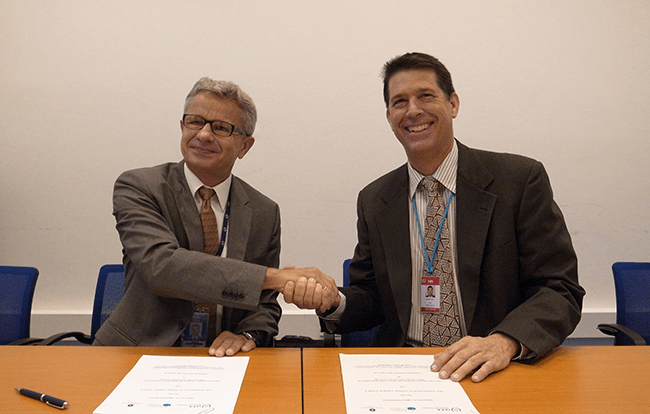University of Hawai‘i: Pacific Disaster Center (PDC) and the International Atomic Energy Agency (IAEA) are now partners in the effort to improve nuclear facility safety.
When the 60th General Conference of the IAEA is convened in Vienna on September 26, Greg Rzentkowski, Director of the Agency’s Division of Nuclear Installation Safety, can report that a key recommendation from the 2015 conference has been firmly acted upon. For nearly six years, IAEA has been using an “External Events Notification and Information System” that receives earthquake data from the U.S. Geological Survey (USGS) and compares the intensity of the earthquake with the intensities used in the design of any nuclear power plants in the affected area. The recommendation in the 2015 General Conference Resolution was that hazards other than earthquakes should be included in the External Events System.
On August 17, PDC and IAEA signed an agreement that establishes a cooperative relationship between the two organizations. The primary outcome of the partnership will be the leveraging of PDC’s DisasterAWARE—a web-based, global-scale multi-hazard monitoring platform—to assist IAEA and its Member States in minimizing risks to and mitigating the effects of natural hazards on nuclear power plants around the globe. The incorporation of DisasterAWARE within IAEA’s External Events Notification and Information System will add carefully vetted, visualized, real-time data on hazards such as tsunamis, tropical storms, volcanic eruptions, floods, landslides, fires, and other severe weather to the earthquake information currently available.
Chiesa said, “The outcome of this collaboration has the potential to benefit so many people around the world. We are all aware of how mother nature can defeat even the best plans of man. PDC is excited by the prospect of using DisasterAWARE to contribute to safer operation of nuclear facilities. At the same time, we expect that we will gain additional insight in hazard assessment and alerting that will benefit all users of DisasterAWARE.”
Additionally, the three-year collaboration will contribute to numerous benefits for IAEA Member States while advancing the Agency’s work to prepare for and respond to nuclear and radiological incidents and emergencies.
In an IAEA press release, Rzentkowski is quoted as saying, “Although nuclear power plants are designed to withstand earthquakes, floods and other external events, even the best designed and operated facility could be affected by the forces of nature. This makes timely and accurate notifications of external hazards crucial, as they lay the basis for effective emergency planning and response.”
You may want to
- Identify nuclear power plants using Atlas
- Explore the IAEA website
- The University of Hawai‘i (UH) IAEA-PDC news story
- Learn more about DisasterAWARE
- Get an overview of a custom system for Vietnam
- Read about a custom system for ASEAN
- Find out about a custom system for Indonesia

